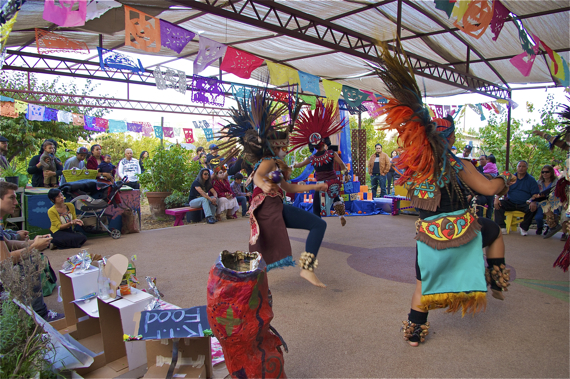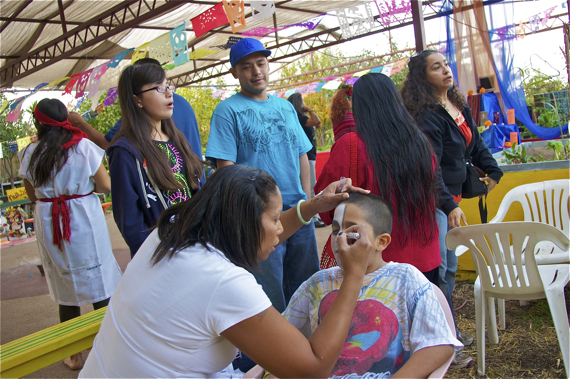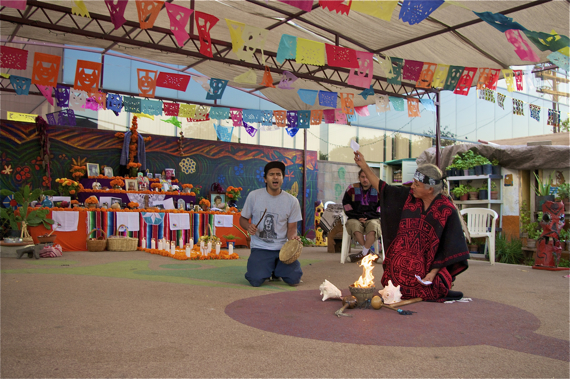
This Sunday, January 31st, the eviction of the community gardening collective known as Proyecto Jardin from the garden space behind White Memorial Medical Center in Boyle Heights will mark a significant change for the neighborhood. In a community that has felt very much at the mercy of externally-driven change in recent years, many residents are determined not to let this shift go unchallenged.
They acknowledge that the land does indeed belong to White Memorial. The 1/3-acre lot was first transformed into a garden in 1999 at the behest of Dr. Robert Krochmol, a resident at White Memorial at the time. And they understand that the hospital does technically have the right to determine how its land will be used and hire whom they wish to administer operations there.
But they also believe that the community has some claim to it because the garden has functioned as a communally-structured community space for most of the last 17 years and because it was local volunteers, advocates, artists, educators, and students that worked to turn the former eyesore into a lush, green oasis of health, culture, creativity, and healing. The special symbolism that the garden holds as a safe and nurturing haven in the community's collective imagination is tightly linked to all those folks that worked so hard to forge bonds between people and place over all those years. It can't be easily replicated by moving the garden to a new site.
Under the leadership of Daisy Tonantzin in the early 2000s, the garden offered residents the opportunity to tap into traditional forms of healing tied to their heritage. In 2005, Tonantzin formalized her efforts to preserve traditional methods with the launch of Caracol Marketplace -- a monthly gathering of artisans featuring food, handmade jewelry, healing herbs and products, art, dance, and music. Caracol Marketplace has since moved to Tropico de Nopal Art Space and Gallery, but its presence in the early days helped reinforce the sense that the garden space represented so much more than just a nice spot to grow vegetables.
Under the more recent administration of Irene Peña, activities at the garden have continued to be guided by the four pillars of community health -- good food, physical activity, traditional healing arts, and community building -- and adhered to a communal approach (families have plots in communal beds, help take care of each others' plots, and share in the larger harvest). And it has served as a site for community celebrations, spiritual rituals and reconnections, youth engagement and mentoring, and the sharing of knowledge among the generations.

But keeping the garden afloat hasn't always been easy, Peña has acknowledged.
Organizing a communal space and operating in true democratic fashion can be a bit like herding cats -- something which any cat owner will tell you is neither a picnic nor something that gets easier over time. And when you don't have a lot in the way of formal structure, fixed staff, or funding, it can be tough to maintain both the day-to-day operations of a labor-intensive garden space and the community-building efforts needed to keep the gardeners and the larger community engaged. All of which becomes even more complicated when you factor in the natural turnover that happens as children grow up, people struggle to balance work and family obligations, interns and college students head out into the world, and budding activists, energized by what they learn at the garden, take up other causes.
As a result, the garden has gone through several fallow periods over the years. And each time that it has, it seems, its future has been called into question.
In 2008, for example, the hospital considered paving the garden over and putting bungalows on the site, according to Peña. In more recent years, the conversation has shifted to how activities at the garden could be better integrated with hospital operations (the two were largely independent of each other for most of the garden's existence) and how participation could be increased. At one point, Peña said, the hospital had even asked her to turn in daily and, later, weekly sign-in sheets, complaining that not enough people were using the garden during the week.
Peña tried to help the hospital understand that, in a lower-income immigrant community, people worked long and sometimes unpredictable hours, and generally had family obligations during the week.
But this summer, as Peña and administrators debated potential changes to Proyecto Jardin's lease, the hospital seemed to be convinced there was more that could be done to keep the space active.
In my conversation regarding the eviction of Peña and Proyecto Jardin volunteers with Cesar Armendariz, Vice President of Business Development at White Memorial, it was clear that some of the hospital's most pressing concerns were still making the garden more active, accessible to more people, and more consistently productive.
"The garden is important to [the hospital]," Armendariz said yesterday, citing concerns about the high rates of obesity, diabetes, and heart disease in the community. An innovative redesign of some of the space, he continued, could result in a much greater harvest. Coupled with cooking classes and other related health activities, the bigger harvest could lead to better health outcomes for many more people.
"That's the vision" for the garden, he said in summary. "To grow it...[and] to make sure it is producing all year round."
To make this happen, the hospital will be turning over garden operations to two as-yet unnamed local organizations in the next few months. There are no plans to displace the approximately 40 families currently gardening there, Armendariz reassured me. [The hospital recently requested, in writing, the contact information of participating families so that they could connect with them and facilitate that transition, but has yet to receive it, Armendariz says.]
Until they had formalized agreements with the two new garden administrators, however, Armendariz said, he would not be able to speak to the specifics of how that transition would be handled. But he wanted residents to know that the chosen organizations were both well-known and trusted in the community.
The announcement of the chosen organizations, he said, would be sure to make a "big splash."
The protest planned for this Saturday at the garden suggests that neither Peña nor the various local groups that support her and her work feel very reassured about the future of the site. Rumors that the garden was going to be taken over by the hospital's marketing department or that the new tenants would be asked to adhere tightly to policies shaped by Seventh Day Adventist practices did not help matters [Armendariz says both are untrue; gardeners would only be asked to rest or garden quietly on the Sabbath, and refrain from overnight celebrations or rituals involving the use of open fires.]

More than a dispute between an institution and a grassroots organization, however, the impasse between White Memorial and Proyecto Jardin seems to underscore just how dissimilarly different communities approach questions of health.
Read through any recent report on public health that purports to offer a snapshot of a lower-income community of color and you will see discussions of the social determinants of health and epigenetics, as well as a list of socio-economic factors, all of which are presumed to impact health outcomes in one way or another. Many reports even speak of how health outcomes in immigrant communities tend to worsen the more that those residents assimilate into American culture, society, and behaviors.
Yet the solutions those same health entities tend to offer for problems like obesity -- a condition that, in lower-income communities, often results from trauma, stress, depression, and/or a lack of stability in addition to limited access to healthy food -- are often surprisingly one-dimensional in scope. Access to healthy food, cooking lessons, access to a garden, access to green space, and knowledge about nutrition are generally seen as the cornerstones to fighting the problem.
Which, of course, they are.
But, it is also true that none of those things will do much good if there is no exploration of why someone is eating poorly or engaging in unhealthy behaviors in the first place. [See my previous discussion of the fast food ban and obesity in South L.A. here]
For the community of activists, artists, and advocates that have either toiled away at Proyecto Jardin at some point, lent support to its activities, or been active in building community around the more complex and intersectional approach to health Peña has used over the years, the hospital's promise of greater harvests leaves them unconvinced that administrators truly understand residents or their health needs. And what they have claimed to be a lack of effort on the part of the hospital to speak with the community about the future of the garden only seems to confirm that.
"It is a rather overwhelming imbalance of power," concludes Peña.
Peña and her volunteers must vacate the premises this Sunday. If you're interested in learning more about some of local residents' concerns or visiting the garden before it changes hands, you can drop by 1718 Bridge St. in Boyle Heights between 9 a.m. and 3 p.m. on Saturday, January 30. Find more details here.






